Table of Contents
QUICK SUMMARY:
Goal-setting frameworks provide structured approaches to defining and achieving objectives. This article shares 19 top frameworks, including SMART goals, for aligning team efforts and driving success in marketing campaigns. Effective goal setting ensures clear direction, accountability, and adaptability, making ambitious targets achievable and maintaining progress toward long-term visions.
Goal setting is more than a task on a to-do list; it's the foundation for achieving success for your digital marketing agency. An overarching goal guides the direction of your agency, but reaching that summit requires breaking it down into annual, quarterly, and monthly goals. A clear vision and proper framework are essential when creating broad objectives and specific business goals. Let's explore why.
The goal-planning process ensures your team's objectives are aligned, offering a strategic path forward. The right goal-setting technique gives them a roadmap to follow.
It’s really easy in life and business to just flow following the status quo. Without setting aggressive goals, it’s very possible to look back on the past quarter or past year and see that your business is no better off now than it was in the past. If you want to grow or want to improve, you need to think about what that looks like and then make a plan to achieve it.
Jens Rhoades, Owner, Floodlight SEO
It doesn't matter if you're focusing on strategic goals for the entire organization or monthly targets for a specific client; a solid goal-setting approach ensures everyone is moving in the same direction.
What happens when goals are missed, you might ask? Evaluating these setbacks is crucial for professional growth and team-member performance. Adjusting and setting smarter goals is part of an ongoing process that allows your agency to adapt and thrive.
In this guide, we'll review the top goal-setting frameworks that will help your agency set and achieve success.
Whether it's your team's first venture into goal setting or you’re a seasoned professional seeking a fresh perspective, these frameworks can transform how your agency plans and executes goals.
The Importance of Goal Setting at a Marketing Agency
Goal setting is vital to any organization's success, but it holds particular weight in the fast-paced world of marketing. The right goal-setting method turns ambitious visions into specifically defined tasks, making even the most challenging goals attainable.
Clear objectives help us define the direction and purpose of the marketing campaign. They provide a clear focus and ensure that all efforts are aligned toward achieving the desired outcomes. Clear and specific objectives provide direction, measurement, accountability, resource allocation, and strategy development.
Anatoly Zadorozhnyy, SEO Manager, 1on1.net
Using techniques like the SMART goals framework (and our very own MASTER goal-setting framework, but more on that later) allows you to chart out a course that makes the organization's mission achievable, outlines clear steps to achieving those goals, holds employees accountable, and provides a sense of direction and purpose.
Aligning Goals With Business Objectives
Aligning monthly, quarterly, and annual goals with the organization's overarching business objectives creates a clear and coherent roadmap for success.
By defining key results and ensuring that goals are in sync with the broader mission, this alignment fosters a synergy that propels the organization forward.
Specific, actionable goals establish a unified direction and enhance productivity across all levels, leading to a more focused and effective pursuit of your agency’s primary objectives.
Without a clear and specific objective, it becomes nearly impossible to measure, and regardless of mission or vision, there is no way to be held accountable.
Daniel Patton, CEO, Rothbright
Using Measurable Goals To Generate Targeted Results
Creating goals that are specifically defined and aligned with the desired outcomes ensures that resources are used effectively.
Whether it's a career goal for an individual or a short-term target for a campaign, using a targeted framework to create goals focuses energy and attention on what truly matters.
Tracking progress and adjusting as needed leads to more targeted results, providing a dynamic and adaptable roadmap to success.
I think, more often than not, people get into trouble when they forget to make a plan to get from where they are to where they want to be. They just set a goal that’s little more than a hope and prayer. Hope and prayer are wonderful things, but they make for terrible business strategies.
Jens Rhoades, Owner, Floodlight SEO
Using Goals To Evaluate Team Performance
The practice of setting and tracking goals not only helps achieve desired outcomes but also serves as a vital tool for evaluating performance. Challenging goals that are properly aligned and tracked provide benchmarks for assessment.
If you don't set clearly defined goals, then you don't have success clearly lined up. And if you don't have that, how can your team succeed for your client?
Kevin Heimlich, Founder, The Ad Firm
This approach makes each employee accountable and supports professional growth, as it offers clear insights into individual and team strengths and areas for improvement.
The importance of setting, aligning, tracking, and evaluating goals in a marketing agency cannot be overstated. By understanding and implementing the appropriate frameworks, you lay the path connecting everyday tasks to long-term success. Whether achieving challenging annual goals or meeting specific monthly targets, the right goal-setting practices become the indispensable compass guiding your team toward excellence.
Top 19 Goal-Setting Techniques for Your Agency, Your Team, or Your Clients
Goal setting is not just about identifying targets; it's about choosing the right framework that aligns with your agency's unique needs and dynamics.
Over time, various goal-setting frameworks have emerged, each with its unique approach. While SMART goals is probably the most popular, it is not the only option. Exploring other frameworks offers new perspectives and–perhaps–better alignment with your agency’s specific needs and challenges.
Whether you're looking to revamp your existing goal-setting process or introduce new methods to your team, this comprehensive analysis will guide you in making an informed decision.
SMART Goals
SMART is a popular and widely used framework for setting objectives. The SMART acronym breaks down into Specific, Measurable, Achievable, Relevant, and Time-bound criteria.
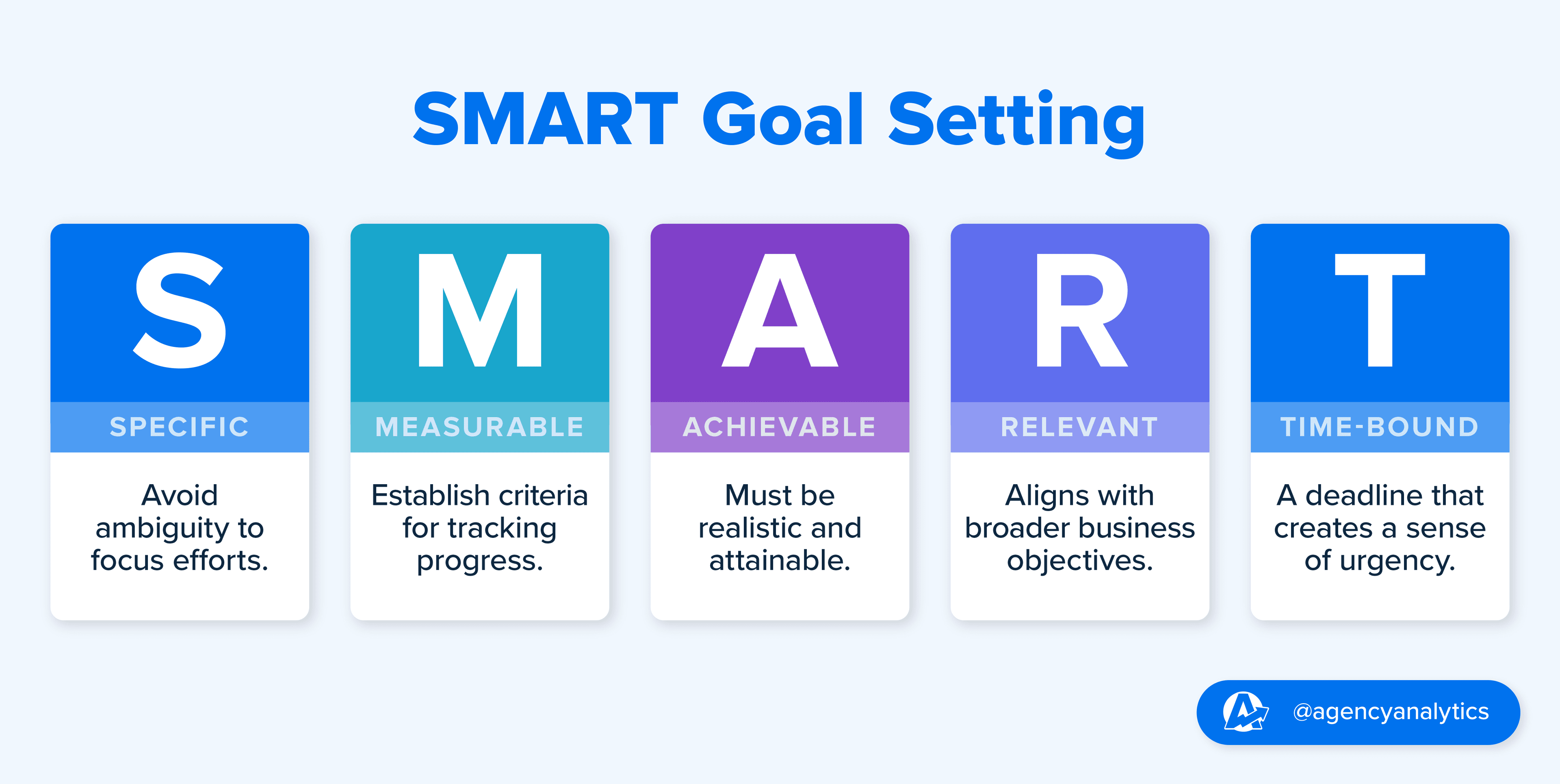
Specific: Clear and precise goals
Measurable: Able to quantify or track progress
Achievable: Realistic and attainable
Relevant: Aligns with broader objectives
Time-bound: Has a set deadline
EXAMPLE: Increase organic traffic by 20% within three months by publishing 12 SEO-optimized blog posts.
If you're looking to run a tight ship with clear deadlines and measurable outcomes, SMART goals are your reliable friend. Just don't expect them to breakdance at the office party.
MASTER Goals
The MASTER Goals framework is an evolved version of SMART, adding flexibility and motivation to the mix. Developed by the AgencyAnalytics senior leadership team, the acronym MASTER expands into Measurable, Achievable, Specific, Transforming, Evolving, and Relevant.

Measurable: Fixed tracking criteria
Achievable: Realistic but challenging
Specific: Clear and focused
Transforming: Significant change or improvement.
Evolving: Adaptable to changes
Relevant: Aligns with bigger objectives
EXAMPLE: Launch a client onboarding video series by Q2, aiming to create a visual experience that wows clients and track feedback for improvements post-launch.
If SMART goals are the disciplined older sibling, MASTER goals are the cool, adaptable younger one. They know the rules but aren't afraid to bend them. Marketing agencies navigating fast-changing landscapes may find MASTER's flexibility and motivational factors a refreshing dip in an otherwise stagnant goal-setting pool.
OKRs
OKRs involve setting clear Objectives and defining the Key Results to measure progress towards these objectives.
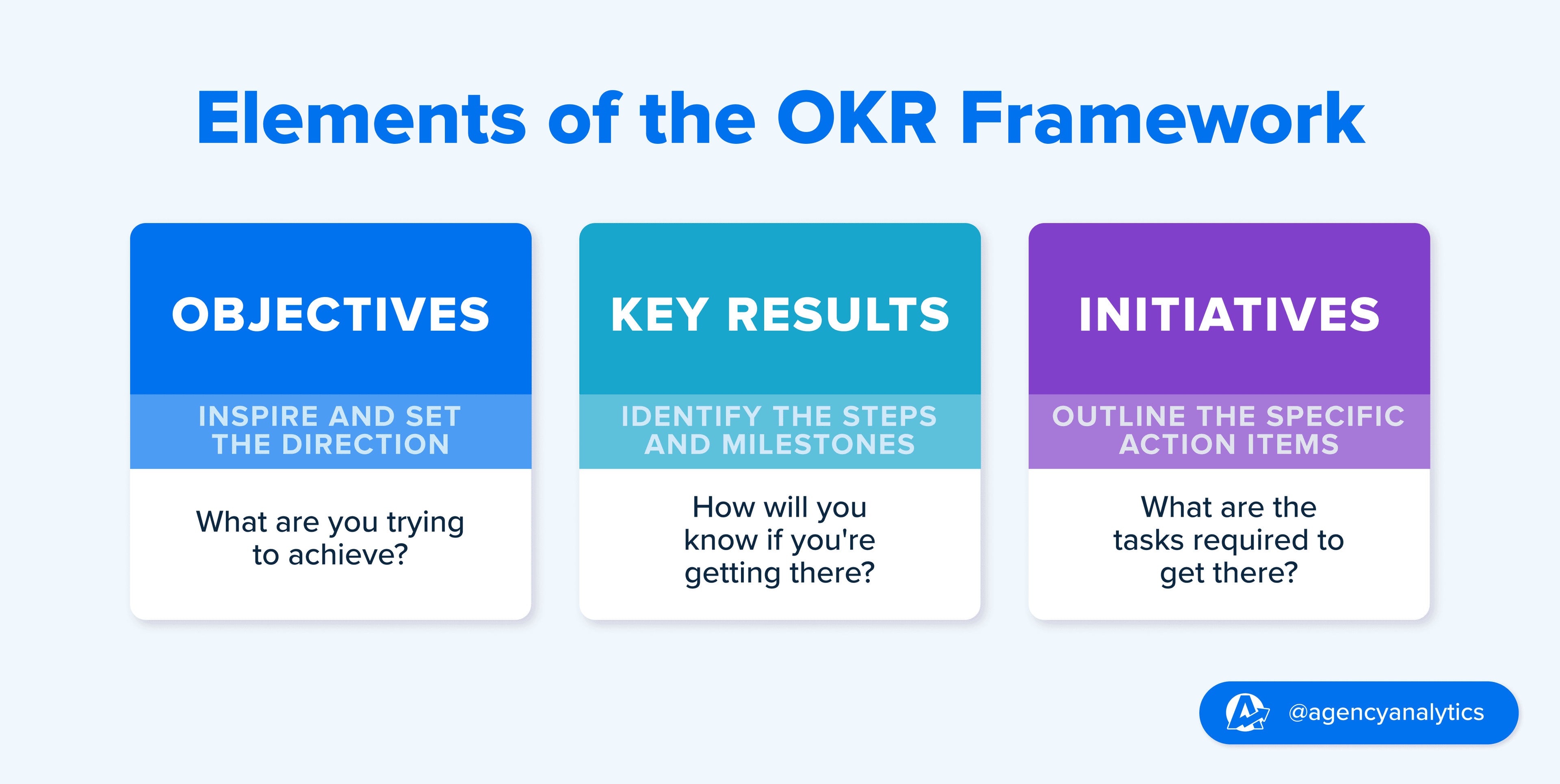
Objectives: Broad, qualitative goals
Key Results: Specific, quantitative metrics to measure progress
Initiatives: Involves breaking the objectives and key results into the smaller initiatives required to achieve the goal
EXAMPLE: Boost content visibility by publishing 250 blogs and achieving 50,000 monthly pageviews by Q3.
OKRs (although they really should be called OKRIs) are perfect for those who like a dash of ambition with a sprinkle of measurability.
WOOP Goals
WOOP is short for Wish, Outcome, Obstacle, and Plan. It’s a scientific approach to motivation.

Wish: Starts with an aspirational wish or desire.
Outcome: Identifies the best outcome if the wish is fulfilled.
Obstacle: Recognizes potential challenges and hurdles.
Plan: Develops a concrete plan to overcome obstacles and achieve the wish.
EXAMPLE: Automate client reporting to save 30+ hours per month, overcoming limited staff tech expertise by investing in the easy-to-use AgencyAnalytics reporting tool.
WOOP there it is! If you're a scientific-minded agency looking to complete goals with a methodical approach and psychological insight, WOOP is your alternative to the SMART system.
EOS Rocks
EOS (Entrepreneurial Operating System) Rocks are priorities that need to be accomplished to keep the business progressing.

3-7 Priorities: Vital for the next 90 days
Clear Responsibilities: Who's doing what
Deadlines: Must be achieved in a specific timeframe
SALES TEAM EXAMPLE: Onboard five high-value clients by end of Q1 by implementing targeted sales campaigns and streamlined SEO proposal processes.
If your agency's goals were stuck between a rock and a hard place, EOS Rocks might just be the lever you need.
PACT Goals
PACT goals stand for Purposeful, Aligned, Continuous, and Tracked. They emphasize alignment with a greater purpose and continuous tracking.
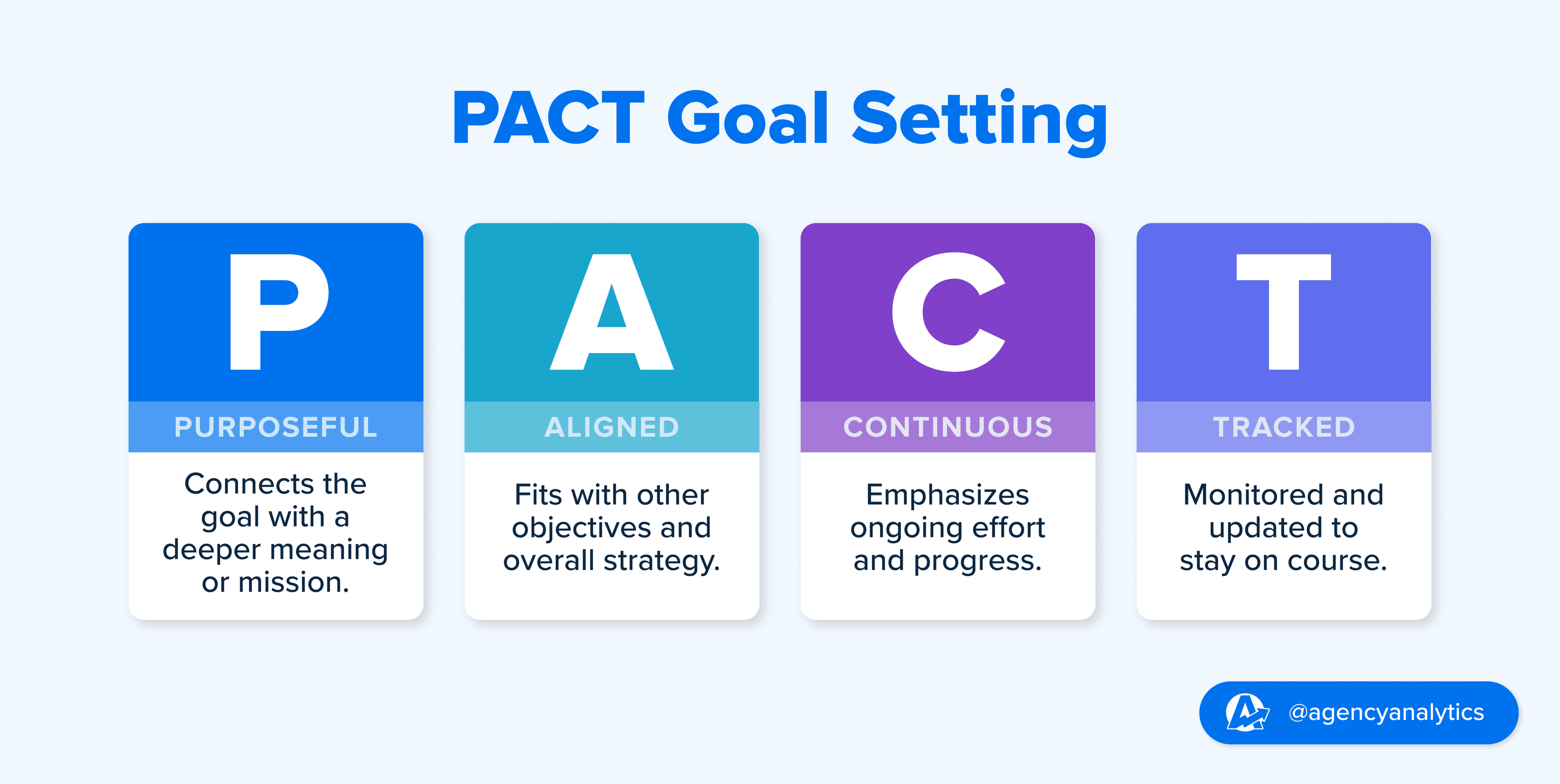
Purposeful: Connects the goal with a deeper meaning or organizational mission.
Aligned: Ensures the goal fits with other objectives and overall strategy.
Continuous: Emphasizes ongoing effort and progress towards the goal.
Tracked: Emphasizes regular monitoring and updates to stay on course.
EXAMPLE: Empower team members by creating 10 training videos, holding monthly skill development workshops, and assessing knowledge growth quarterly.
For those who want to achieve more than just measurable goals and put their best foot forward, PACT goals offer improved alignment and continuous tracking, making this framework a suitable alternative for agencies focusing on team and personal goals.
One Word Goals
A One-Word Goal condenses the essence of what you want to achieve into a single term. It's not just about simplicity but aligning everything you do with this central theme.

A single word: Represents the focus for the year, guiding all strategies and decisions. Although it is ok to expand on the One Word to show how it relates to your agency, team, or client.
EXAMPLE: Elevate!
Transform agency-client relationships by setting a new standard in reporting excellence and empowering agencies to reach their full potential.
Perfect for the marketing agency that believes less is more. If you're good at slogans, you might already be a one-word wizard!
The Golden Circle Framework
The Golden Circle digs into the heart of organizational direction. It starts with 'Why' to define the core purpose, 'How' to explain the methods, and 'What' to describe the outcomes.

Why: Understanding the core purpose
How: Explaining the methods and processes
What: Defining the tasks, outcomes and results
EXAMPLE: Help clients grow faster by using AI reporting tools to provide timely, insightful reports within a live, AI-enhanced analytics dashboard in Q1.
If you love peeling back the layers of a strategy like it's an existential onion, the Golden Circle is your philosophical playground. Great for agencies that believe marketing isn't just what you do; it's who you are.
ABC Goals
ABC Goals strip down goal setting to its most fundamental essence: making sure goals are within reach, resonate with what you believe, and have everyone's commitment.

Achievable: Goals must be attainable
Believable: Have confidence in skills and capabilities.
Committed: Everyone must be committed to the goals
EXAMPLE: Increase monthly revenue by 15% by expanding services to eCommerce clients and measuring success through quarterly revenue reports.
If your marketing agency believes in getting back to the basics and loves a catchy acronym, this approach might be the "easy as 123" solution you’re looking for.
ABCS Goals
ABCS Goals take the ABC approach a step further, with a call to aim for the stars, believe in your abilities, commit with passion, and reflect on the specifics.
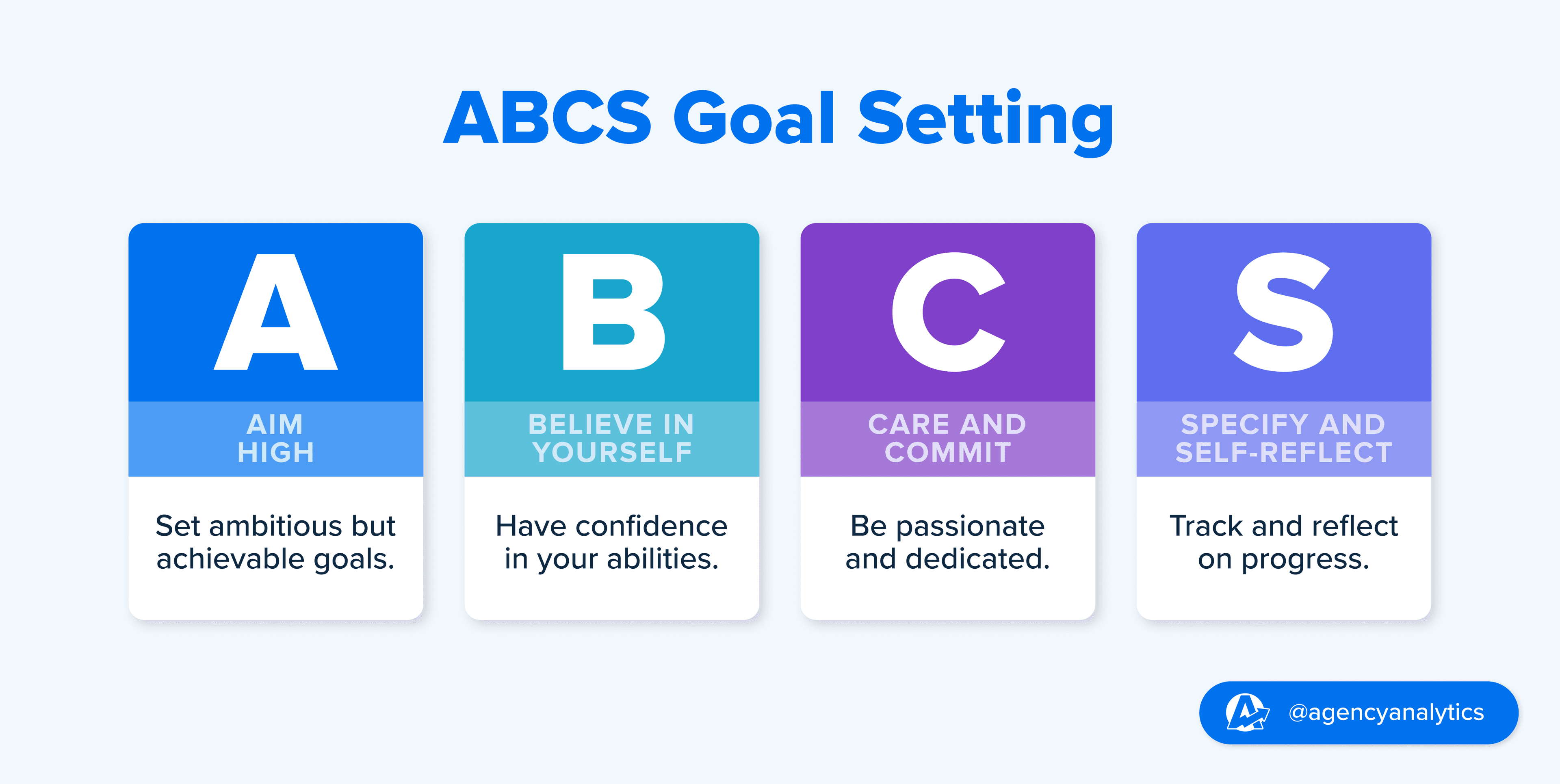
Aim High: Set ambitious but achievable goals
Believe in Yourself: Have confidence in your abilities
Care and Commit: Be passionate and dedicated
Specify and Self-Reflect: Detail the goals and reflect on progress
EXAMPLE: Launch a new social media service offering and add 20 new clients by year-end, checking in quarterly on progress and client response to the new services.
If you're already a fan of the classics but just want a bit more flavor, ABCS might have that extra spice you need. Don't worry, no one will call you the alphabet soup agency. Well, probably not.
CLEAR Goals
CLEAR is an acronym for Collaborative, Limited, Emotional, Appreciable, and Refinable.

Collaborative: Encourages teamwork and shared responsibility.
Limited: Focuses on scope and time to make goals manageable.
Emotional: Recognizes the emotional connection to motivation and engagement.
Appreciable: Breaks larger goals into smaller, achievable tasks.
Refinable: Allows for adaptation and change in response to new information.
EXAMPLE: Collaborate across sales, marketing, and account management to launch a new campaign focusing on eCommerce brands, exciting clients with personalized outreach, and refining strategies based on results.
CLEAR goals are perfect for those who have tripped over the vague goals of other frameworks. Ideal for businesses that thrive on collaboration and need emotionally resonant and flexible targets, CLEAR allows you to steer the ship without hitting the choppy seas of unrealistic or irrelevant goals.
DUMB Goals
A tongue-in-cheek antithesis to SMART goals, DUMB goals focus on visionary thinking and big-picture perspective.
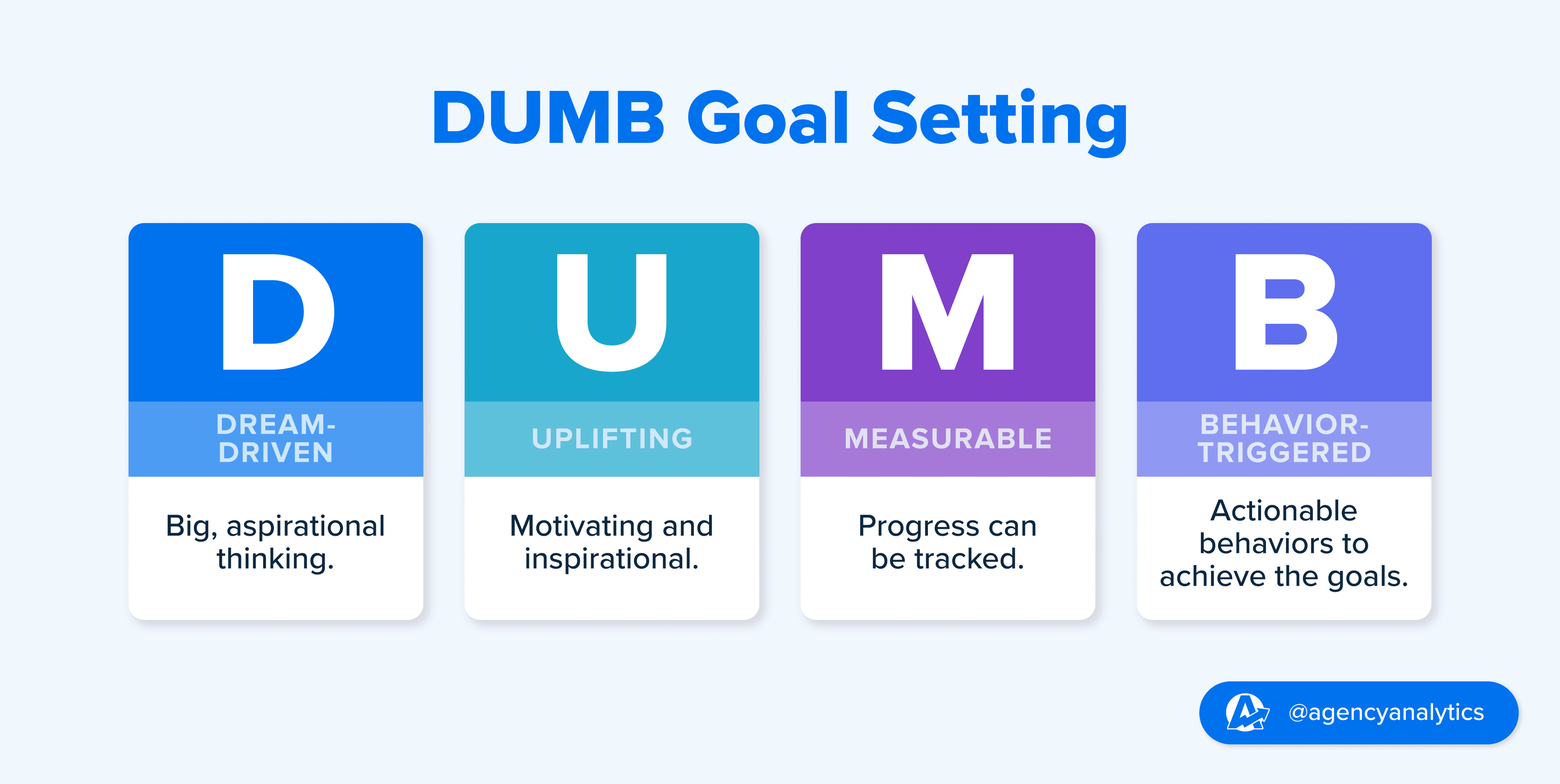
Dream-driven: Encourages big, aspirational thinking.
Uplifting: Creates positive motivation and inspiration.
Measurable: KPI methodology for tracking progress.
Behavior-triggered: Focuses on actionable behaviors that lead to achieving the goal.
If you want to achieve something grand and inspire your team with visionary thinking, then DUMB is smarter. Who knew?
EXAMPLE: Become the number one reporting platform for agencies worldwide, helping them save over 1 million hours annually with streamlined onboarding and automated client reporting.
HARD Goals
Have you ever heard the old adage that the hard thing to do, and the right thing to do, are often the same thing? HARD goals emphasize connection, visualization, necessity, and challenge.

Heartfelt: Connects goals with passion and emotion.
Animated: Encourages visualizing the goal as a living entity.
Required: Stresses the necessity and urgency of the goal.
Difficult: Emphasizes stretching beyond comfort zones.
EXAMPLE: Adopt an industry-leading automated reporting tool by Q2 so we can quickly and easily create reports and dashboards that we're proud to offer to clients, while pushing the limits of what’s possible with AI-enhanced analytics before our competitors beat us to the punch.
If you think realistic goals are too easy, go HARD. Perfect for those looking to achieve goals with a bit more heart and soul, perhaps in creative or passionate industries, where putting emotions into goals isn't just wise, it's required.
The Goal Pyramid
The Goal Pyramid is a hierarchical framework that structures goals from the ground up, focusing on small, manageable tasks at the base, building up to intermediate objectives, breaking down task complexity, and culminating in the ultimate goal at the peak.

Base Layer: Small, achievable tasks that form the foundation
Middle Layers: Intermediate objectives and sub-goals
Peak: The ultimate, overarching goal that guides the entire structure
EXAMPLE: Scale the agency to 100 clients before the end of 2027 by securing 20 new clients annually and streamlining client reporting to make onboarding faster and easier.
If your marketing agency loves architectural metaphors or if you've ever thought marketing is just one big game of Jenga, The Goal Pyramid might be right for you.
B.H.A.G.
B.H.A.G. (Big, Hairy, Audacious Goals) is all about setting long-term goals that are not just big but intimidating and boundary-pushing. It's about aiming for something that will stretch the entire organization.
When using the B.H.A.G. framework, goals should align with what your agency is deeply passionate about, what it does best, and what drives it to succeed, forming a compelling and unified direction for long-term achievement.
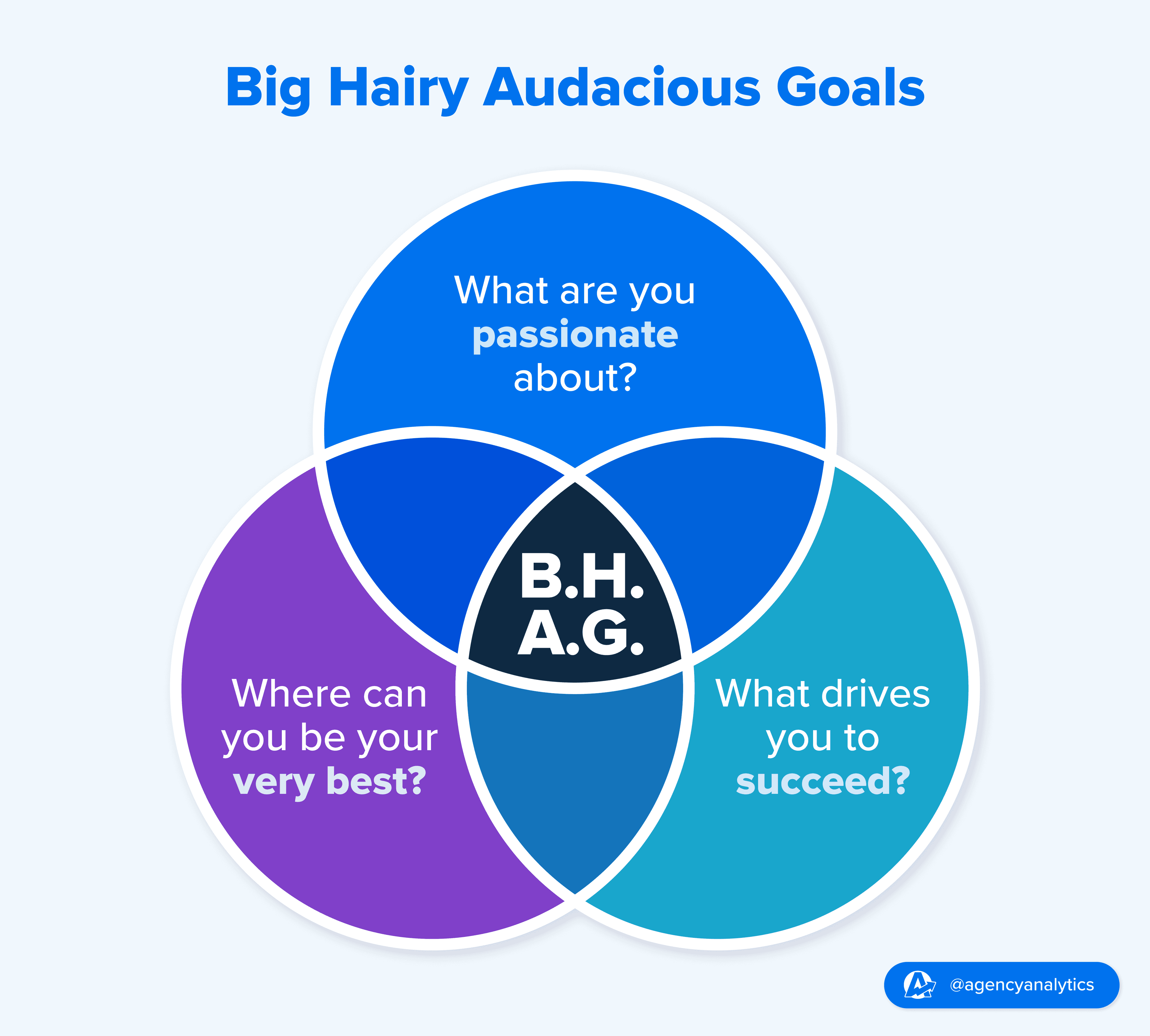
Long-term: 10 to 25-year goals that are ambitious and boundary-pushing.
One Big Goal: designed to push the agency outside its comfort zone.
EXAMPLE: Expand from a boutique agency to a global powerhouse, managing multimillion-dollar campaigns for Fortune 500 companies across five continents by 2030.
If your agency dreams big and has a wild imagination, Big Hairy Audacious Goals might be the route for you. Warning: Requires a sturdy comb to navigate the hairy bits.
GROW Goals
GROW is a coaching model that stands for Goal, Reality, Options, Way Forward.
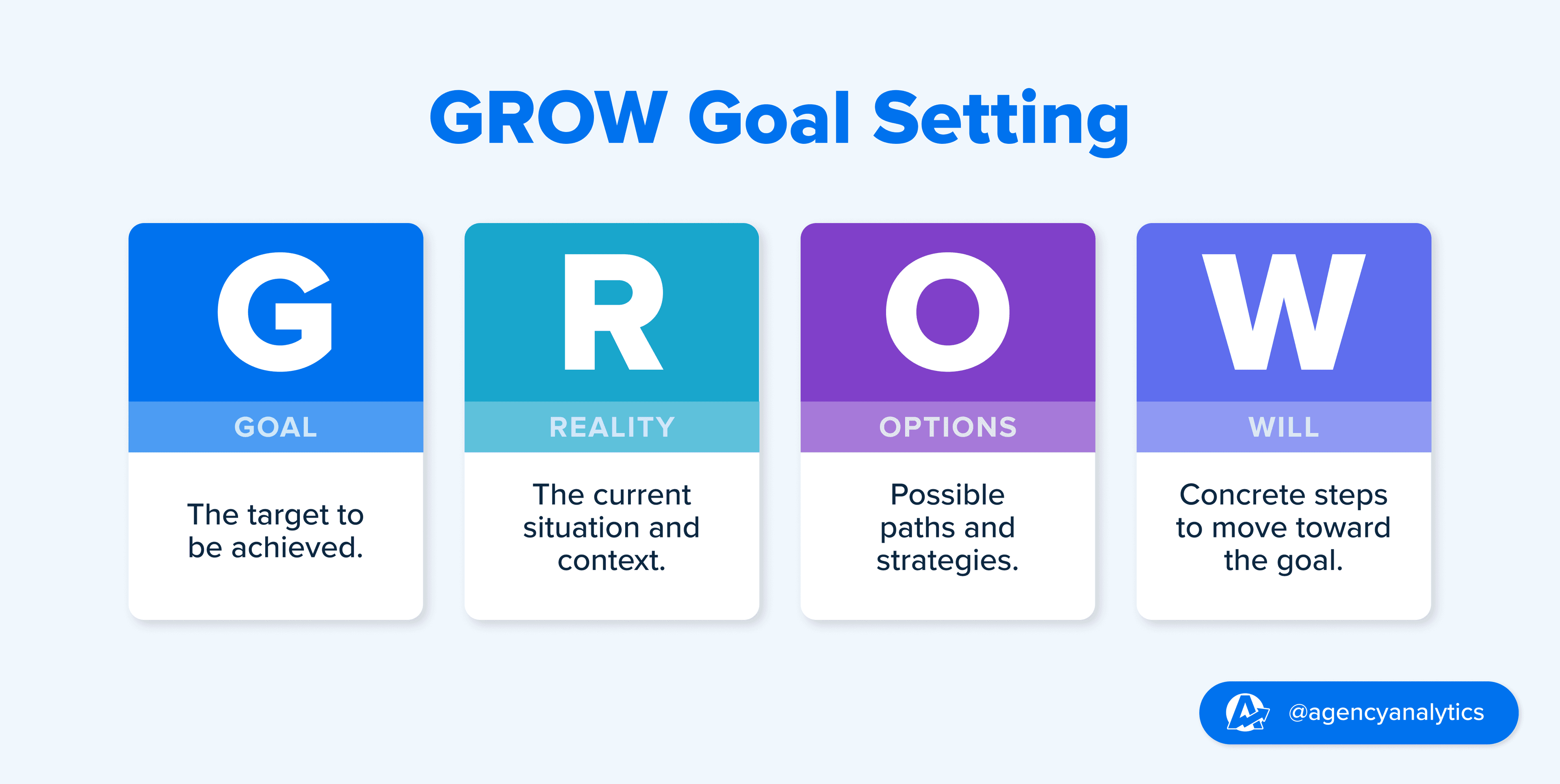
Goal: Identifies the target to be reached.
Reality: Assesses the current situation and context.
Options: Explores possible paths and strategies.
Will (or Way Forward): Plan concrete steps to move toward the goal.
EXAMPLE: Expand into new vertical markets by hosting three niche-focused events by year-end, overcoming limited awareness through collaboration with industry leaders.
Want to set goals that'll help you GROW rather than wither? This framework is perfect for coaching and personal development, guiding you from a specific goal to a completion date with room to explore different paths.
WISE Goals
WISE goals stand for–well–a lot of different things. Oddly, this goal-setting framework seems to have a lot of interpretations of the acronym. For example, the W stands for Written, Wonderful, Worthy, or Wisdom, depending on the source. However, the most common understanding of WISE goals is that it stands for Written, Integrated, Synergistic, and Expansive.

Written: Emphasizes the importance of documenting the goal, making it tangible and clear.
Integrated: Ensure that the goal fits cohesively within the overall strategies and objectives.
Synergistic: Collaborate with team members to amplify collective success.
Expansive: Think broadly to encourage growth and new possibilities.
EXAMPLE: Focus on profitable channels by creating standout reporting templates, assessing client preferences, and ensuring client data security.
If SMART goals don't feel quite wise enough for you, try these. Great for setting personal goals or organizational objectives that focus on inspiration, community impact, and enjoyment, WISE ensures your goal-setting isn’t just about checking off a to-do list but also putting your best philosophical foot forward.
Cascading Goals
Cascading Goals is about creating a waterfall of alignment. From top-level organizational aspirations to individual tasks, every goal is connected, ensuring consistency.
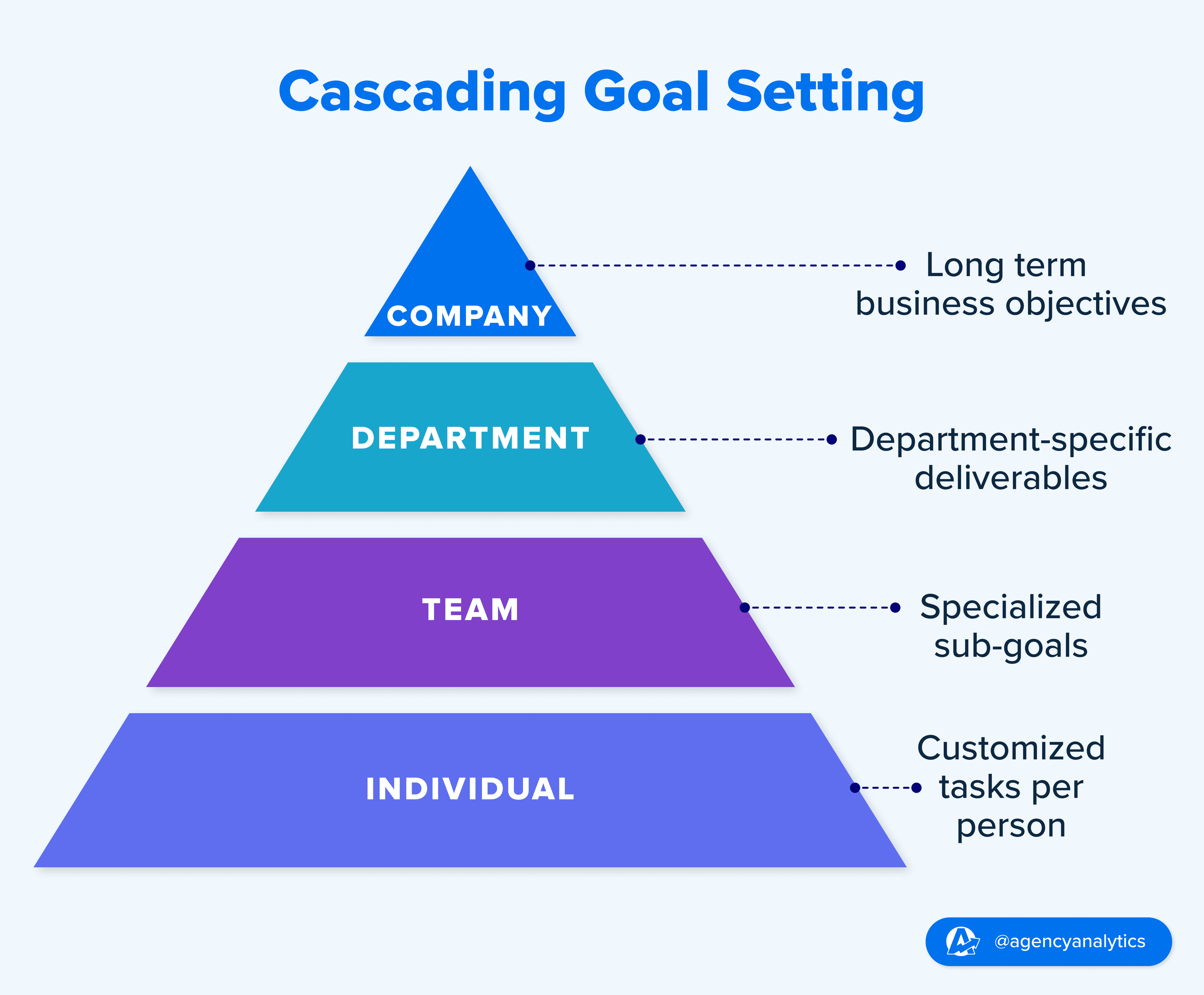
Organizational Goals: Broad strategic intentions
Department Goals: Tied to organizational goals and divided by department
Team Goals: Sub-goals that are driven by a team of subject matter experts
Individual Goals: Connected to departmental aims, customized for each person
EXAMPLE: Support annual revenue growth target of 25% by increasing sales team outreach by 50% and closing 15 new client contracts this quarter.
Imagine every goal in your agency flowing smoothly from one level to the next, like a well-coordinated waterfall. Cascading Goals is for agencies that believe harmony isn’t just for choirs; it's for champions.
Although Cascading Goals is considered a stand-alone goal-setting framework, it can also be applied to other frameworks to take top-level goals and create smaller goals for each manager and individual contributor.
Tiered Goals

Similar to cascading goals, the tiered goals framework is a strategic approach that organizes goals into different levels or tiers. This hierarchical structure ensures alignment across various aspects of an organization, creating a cohesive and unified direction.
Strategic Goals: These are the highest-level goals, closely aligned with the organization's overall mission and vision.
Tactical Goals: Break down strategic objectives into more manageable chunks and define the paths to achieve them.
Operational Goals: The day-to-day tasks and responsibilities necessary to reach the higher-level goals.
EXAMPLE: Support the agency's objective of becoming a trusted leader in the hospitality industry by securing partnerships with 50 luxury hotel brands within five years, starting with tailored campaigns for three major chains this year and optimizing ad performance weekly.
By organizing goals into different tiers, this framework ensures alignment between daily operations and long-term vision. Each level supports the next, creating a cohesive roadmap towards achieving overarching objectives.
A 6-Step Guide for Choosing the Right Goal-Setting Framework
Choosing the right goal-setting framework is not about selecting the most popular or the trendiest one. It's about pinpointing the framework that aligns best with your agency’s or your client's business needs and company culture.
Get it right, and you've got a roadmap that transforms those audacious goals into achievable tasks. Get it wrong, and you risk having a whiteboard full of good intentions that never manifest into results.
Now, let's get you suited up with the perfect framework.
Step 1: Understand the Business Objectives
Every business, yours or your client's, has a primary objective. Knowing the business goal helps you sort through frameworks more efficiently, whether it's rapid growth, sustainability, or diversification. For instance, if a client is eyeing rapid growth, something ambitious like B.H.A.G. (Big Hairy Audacious Goal) could be a fit. Here are more examples of common business goals and the framework that might be the best match.
Boosting Social Media Presence: If your or your client's main goal revolves around enhancing a social media presence, the SMART Goal Framework is usually a good bet. It's precise, actionable, and helps measure key performance indicators.
Increasing Lead Generation: For an objective that's all about numbers, the MASTER Goals framework brings both tangibility and a robust structure that helps manage complex sales funnels.
Expanding Customer Base: When the focus is on attracting more clients or penetrating new markets, PACT Goals offer the flexibility to adapt strategies as circumstances change.
Improving Customer Satisfaction: The One Word Goals framework is a solid choice when the aim is to focus the company’s efforts on improving customer relations. The framework allows everyone to rally around a single word, like “Trust” or “Quality.”
Streamlining Operations: If the objective is to make internal processes more efficient, EOS Rocks focuses on identifying and tackling the key issues head-on.
Goal setting is critical for establishing agency-client alignment. When we set goals in collaboration with our clients, not only are we saying, "This is what we are trying to accomplish," but we're also creating the structure for how to determine if our efforts are successful or not.
Kerrie Luginbill, Chief Strategy Officer, OTM
Step 2: Evaluate Company Culture
A goal-setting framework should feel like an extension of the company's culture. It should be in sync with how employees naturally operate. Some frameworks demand rigorous tracking, and others are more laissez-faire. Make sure you choose a framework that people will actually use, not one that will gather dust in a corner.
We chose to use the OKR framework because it allows us to assign very specific metric outcomes easily and to track against them.
Daniel Patton, CEO, Rothbright
Step 3: Assess Scalability
Not every business stays the same size forever. Maybe your client is a startup today but aspires to be the next tech giant. The chosen framework should meet current needs and be scalable for future growth.
Whether the goals involve creating a killer new product or reaching a revenue milestone, size matters. Are you shooting for the stars with massive goals or trying to make incremental changes? Some frameworks, like B.H.A.G., work better for massive undertakings, while SMART goals might be suited for more medium milestones.
There's not always an end-point to what we're trying to accomplish. For most of our clients, we're on a quest for continuous improvement, so even if we do make our KPIs time-bound, we end up shifting or extending them as we go.
Kerrie Luginbill, Chief Strategy Officer, OTM
Step 4: Evaluate Your Team’s Capacity
It takes an entire team to hit a home run. Evaluate the experience and skill level of the team, especially if new team members have recently joined. The complexity and resources required by a framework should sync with what your team can realistically achieve.
Take EOS Rocks, for example. This framework is complex and layered, requiring a degree of maturity and skill in goal-setting practices. It asks for clearly defined roles, exhaustive discussions, and rigorous tracking. Now imagine implementing this with a team of rookies or new team members still getting a hang of the office coffee machine. Overwhelming? You bet. It could turn your goal-setting exercise into an episode of ‘Who’s Doing What Now?’
On the flip side, let’s look at One Word Goals. This framework simplifies the entire goal-setting process down to, you guessed it, one word. It's straightforward, easy to remember, and doesn’t require a Ph.D. in project management to execute. If your team is young, new, or less experienced in strategic planning, One Word Goals can be a breath of fresh air. Everyone focuses on a singular concept like “Grow” or “Connect,” making it digestible and action-oriented.
Step 5: Weigh the Pros and Cons
Here's where you play matchmaker. Put the shortlisted frameworks side by side and weigh the pros and cons. Is the framework easy to implement? Is it flexible enough to accommodate unexpected changes? No framework will be perfect, but some are definitely better suited than others.
Step 6: Establish an Evaluation Period
Before going all-in, consider a 'test drive' with a roundabout goal and a limited timeframe. Evaluate performance, team buy-in, and how well the chosen framework is helping reach that ambitious goal. It might be wise to pivot if things aren't looking up by the end of the evaluation period.
Selecting the right goal-setting framework goes beyond popular opinion or what the industry is buzzing about. It's about aligning with a strategy that benefits every level of the organization, from top management down to entry-level positions. When deciding between frameworks like SMART, MASTER, and others, remember that what works for one company may not work for another. Make informed choices tailored to your specific needs.
Summary and Key Takeaways
Various frameworks suit different needs, values, and contexts. Whether it's the comprehensive STREAM system, the visionary approach of DUMB goals, or the methodical planning of WOOP, there's a framework to align with your agency and your clients. Understanding these alternatives opens up new avenues for success.
A goal without a plan to achieve it is like a sports car without an engine. It may look pretty, but it’s not going to accomplish much. Make the plan.
Jens Rhoades, Owner, Floodlight SEO
Some universal aspects are common components when examining popular goal-setting frameworks. These aspects resonate across different frameworks because they are foundational to goal-setting.
Aligning Team Goals and Objectives
With the right framework, each team member knows what they're working toward and the time frame in which it needs to be accomplished. This alignment fosters a clear understanding among the whole team, turning individual efforts into a cohesive action plan. It's like running a relay race where everyone is aiming for the same finish line.
No matter how specific or measurable a goal is, if it's not in alignment with the organization's needs, it's not going to move the business forward.
Kerrie Luginbill, Chief Strategy Officer, OTM
Breaking Down the Big Picture into Clear, Achievable Goals
A well-defined goal-setting strategy helps break down the big picture into smaller, more manageable goals. It helps the team to focus on specific targets without losing sight of the overall objective. It's the art of setting up dominos–knock down the smaller goals, and the larger ones will follow.
Keep your goals simple. You should be able to explain them to a five-year-old.
Daniel Patton, CEO, Rothbright
Keeping Goals Relevant and Attainable
A relevant goal-setting framework ensures that the goals are ambitious, attainable, and aligned with the organization's broader vision. This way, the team doesn't end up chasing wild geese, but instead focusing on what truly matters.
Setting a Clear Path Toward Success
Goal setting acts as a blueprint and a compass, guiding the team towards successful outcomes. A well-chosen framework is like having a seasoned co-pilot who helps you navigate the route, making sure you stay on course and reach your destination.
Goals provide a clear direction and purpose for the marketing efforts. They help us and our clients align our activities towards a specific outcome, ensuring that everyone is working towards the same objective.
Anatoly Zadorozhnyy, SEO Manager, 1on1.net
Facilitating Communication and Collaboration
Setting goals that everyone understands and agrees upon fosters a sense of unity among team members. The whole team operates with a shared vision, and this mutual understanding promotes cooperation and collaboration.
Monitoring Key Results and Making Adjustments
A structured approach to setting goals helps track progress and allows for needed adjustments along the way. It's a dynamic process that helps identify when projects are drifting off course and make necessary corrections. Think of it as the rumble strips on the highway, alerting you when you’ve veered off course so you can head back in the right direction.
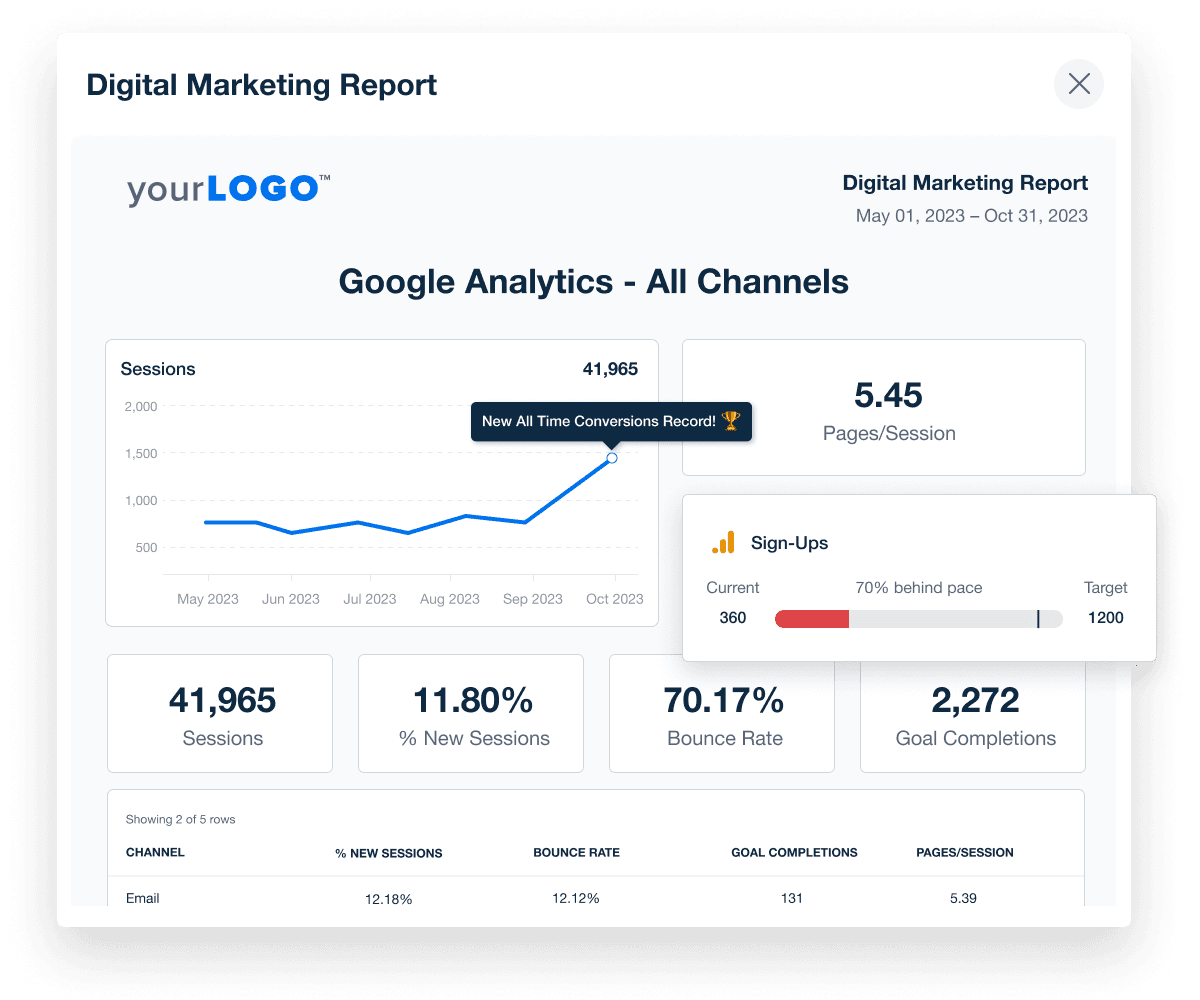
Once you’ve set your goals, track them using the AgencyAnalytics goal-tracking system. Easily monitor progress against daily or monthly goals to make sure you stay on track. Try AgencyAnalytics free for 14 days.
Whether aiming to accomplish smaller goals or striving for a long-term vision, the right framework encapsulates everything from planning to execution, making it an essential component of a successful strategy.
As Kerrie Luginbill shared, "Simply HAVING a widely shared goal that the whole team knows and understands is what matters. Don't overthink it. DO overshare it."
She continued by stating that instead of trying to find the perfect framework for how to write your goals (and then putting them in some database or drawer to never see the light of day again), do this instead:
Determine what is important (i.e. the goal)
Tell your team what it is
Define how you measure it (it doesn't have to be perfect)
Make sure everyone understands the WHY
Track your progress toward it somewhere highly visible
Talk about it all the time
It's okay if what's important changes. The world is constantly changing, you can't expect your business to stay the same!
Kerrie Luginbill, Chief Strategy Officer, OTM
Think of choosing the right goal-setting framework as setting the GPS for your entire organization. It puts everyone on the same page, working towards the same goal, and moving in the same direction. But even the wrong goal-setting framework is better than no goals at all.

Written by
Paul Stainton is a digital marketing leader with extensive experience creating brand value through digital transformation, eCommerce strategies, brand strategy, and go-to-market execution.
Read more posts by Paul StaintonSee how 7,000+ marketing agencies help clients win
Free 14-day trial. No credit card required.






